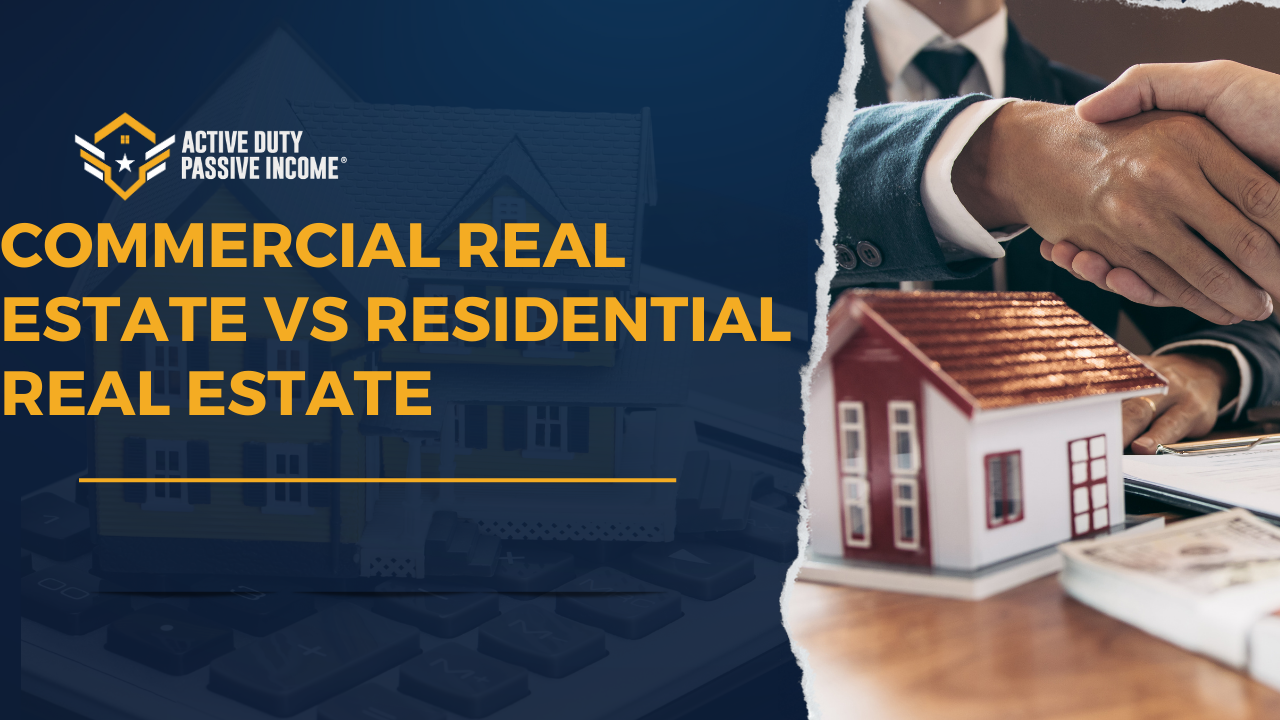In the world of real estate investment, two prominent sectors stand out: commercial and residential. Each offers unique opportunities and challenges, attracting investors with distinct objectives and strategies. Whether you’re considering entering the real estate market as an investor or simply curious about the differences between these two sectors, understanding their nuances is crucial. In this comprehensive guide, we’ll delve into the various aspects of commercial and residential real estate, from the types of loans available to the buying process and everything in between.
Overview of Commercial Real Estate (CRE)
Commercial real estate refers to properties primarily used for business purposes rather than for residential living. These properties can include office buildings, retail spaces, industrial facilities, and multifamily apartment complexes with five or more units. The key distinguishing factor of commercial real estate is its income-producing potential, often through leasing or rental agreements with tenants.
Types of Commercial Real Estate Loans
- Commercial Mortgages: These loans are specifically designed for purchasing commercial properties. They typically have shorter terms than residential mortgages and may require larger down payments.
- Commercial Bridge Loans: Bridge loans provide short-term financing to cover expenses while waiting for a long-term financing solution. They’re commonly used in real estate transactions where timing is crucial, such as when acquiring a property before securing permanent financing.
- Construction Loans: Construction loans fund the development of new commercial properties or the renovation of existing ones. Lenders disburse funds in stages as construction progresses, and repayment terms may vary.
- SBA Loans: Small Business Administration (SBA) loans are backed by the government and offer favorable terms for qualifying small businesses looking to purchase or refinance commercial real estate.
- Commercial Real Estate Lines of Credit: These provide businesses with access to a revolving line of credit, allowing them to borrow funds as needed for various real estate purposes.
The Commercial Real Estate Buying Process
- Identifying Investment Opportunities: Investors conduct thorough market research to identify promising commercial properties. Factors such as location, demand, and potential rental income are carefully assessed.
- Due Diligence: Once a property is selected, due diligence is conducted to evaluate its physical condition, financial performance, zoning regulations, and any legal issues.
- Financing: Investors secure financing based on the type of commercial property and their financial situation. Loan terms, interest rates, and down payment requirements are negotiated with lenders.
- Negotiating Purchase Terms: Negotiations with sellers involve price, terms of sale, and contingencies. Commercial real estate transactions often involve complex negotiations due to the larger financial stakes.
- Closing: The closing process involves finalizing the sale, transferring ownership, and ensuring all legal and financial obligations are met. Closing costs, including legal fees and property taxes, are paid by the buyer.
Overview of Residential Real Estate (RRE)
Residential real estate comprises properties intended for personal living spaces. This category includes single-family homes, condominiums, townhouses, and multifamily properties with fewer than five units. Residential real estate is often considered more accessible to individual investors and homeowners, with a broader market and more straightforward transaction processes.
Types of Residential Real Estate Loans
- Conventional Mortgages: These are the most common type of home loans, offered by private lenders and backed by either Fannie Mae or Freddie Mac. Conventional mortgages typically require a down payment of at least 3% to 20% of the purchase price.
- FHA Loans: Insured by the Federal Housing Administration, FHA loans are popular among first-time homebuyers due to their low down payment requirements (as low as 3.5%) and lenient credit score criteria.
- VA Loans: Reserved for eligible veterans, active-duty service members, and their spouses, VA loans offer 100% financing with no down payment requirement. They also come with competitive interest rates and no private mortgage insurance (PMI).
- USDA Loans: Guaranteed by the U.S. Department of Agriculture, USDA loans are designed to assist low- to moderate-income borrowers in rural areas. They offer no down payment options and flexible credit requirements.
- Home Equity Loans and HELOCs: Home equity loans and home equity lines of credit (HELOCs) allow homeowners to borrow against the equity in their homes for various purposes, including renovations, debt consolidation, or investment.
The Residential Real Estate Buying Process
- Pre-Approval: Prospective buyers obtain pre-approval from lenders to determine their budget and demonstrate their seriousness to sellers. Pre-approval involves a thorough review of the buyer’s financial history and creditworthiness.
- Finding the Right Property: Buyers search for suitable properties based on their budget, location preferences, and desired features. Real estate agents often assist in the search and facilitate property viewings.
- Making an Offer: Once a suitable property is found, buyers submit an offer to the seller through their agent. The offer includes the proposed purchase price, contingencies, and any special terms or conditions.
- Negotiation: Sellers may counter the initial offer, leading to negotiations on price, closing costs, and other terms. Buyers and sellers work with their agents to reach a mutually acceptable agreement.
- Underwriting and Closing: After the offer is accepted, the buyer’s lender conducts underwriting to assess the borrower’s risk and finalize the loan terms. Once approved, the closing process begins, culminating in the transfer of ownership and the disbursement of funds.
Key Differences Between Commercial and Residential Real Estate
- Investment Objectives: Commercial real estate investors focus on generating rental income and maximizing property value appreciation, while residential investors often seek long-term appreciation and potential rental income.
- Property Management: Commercial properties typically require professional management due to larger scale and complexity, whereas residential properties may be managed directly by owners, especially in smaller multifamily units.
- Lease Terms: Commercial leases tend to be longer and more complex than residential leases, with terms ranging from three to ten years or more. Residential leases are typically shorter, typically lasting one year or less.
- Tenant Base: Commercial properties attract businesses as tenants, while residential properties cater to individuals or families seeking housing.
- Regulatory Environment: Commercial real estate transactions are subject to more extensive regulations and zoning laws than residential transactions due to their impact on communities and the economy.
Additional Differences Between Commercial and Residential Real Estate
Scale and Complexity
Commercial Real Estate (CRE):
- Pros: Commercial properties are often larger in scale, offering potential for higher returns on investment. They can include office towers, shopping malls, and industrial warehouses, providing diverse income streams.
- Cons: Managing commercial properties requires specialized expertise and resources. Dealing with multiple tenants, maintenance issues, and lease negotiations can be complex and time-consuming.
Residential Real Estate (RRE):
- Pros: Residential properties are generally easier to manage, especially for individual investors. With smaller-scale properties like single-family homes or duplexes, landlords may have fewer tenants and maintenance concerns.
- Cons: Residential investments may yield lower returns compared to commercial properties. Rental income from residential units may fluctuate, and turnover rates can impact cash flow.
Lease Structure and Terms
CRE:
- Pros: Commercial leases often come with longer terms, providing stability and predictable income for investors. Triple net leases, common in commercial properties, require tenants to cover property expenses such as taxes, insurance, and maintenance, reducing the landlord’s financial responsibilities.
- Cons: Negotiating commercial leases can be intricate and may require legal assistance. Vacancies in commercial properties can have a significant financial impact due to higher operating costs and longer lease-up periods.
RRE:
- Pros: Residential leases are typically shorter in duration, allowing landlords to adjust rental rates more frequently to market conditions. Landlords may have more flexibility in managing residential properties and responding to tenant needs.
- Cons: Tenant turnover in residential properties can lead to vacancies and turnover costs such as advertising, cleaning, and repairs. Landlords may face challenges with non-payment of rent or property damage by tenants.
Financing and Investment Criteria
CRE:
- Pros: Commercial real estate loans may offer higher loan amounts and more favorable terms for qualified investors. Lenders assess the income-generating potential of commercial properties, considering factors such as occupancy rates, lease terms, and property value appreciation.
- Cons: Securing financing for commercial properties can be more stringent and require larger down payments. Investors may face higher interest rates and fees compared to residential loans, reflecting the higher risk associated with commercial investments.
RRE:
- Pros: Residential real estate loans are more widely available to individual investors and often come with lower down payment requirements. Government-backed loan programs such as FHA and VA loans provide opportunities for first-time homebuyers and veterans to finance residential properties with minimal upfront costs.
- Cons: Residential mortgage rates may be slightly higher than commercial rates, especially for investment properties. Lenders evaluate borrowers’ creditworthiness and income stability when approving residential loans, which can be challenging for some buyers.
Conclusion
The distinctions between commercial and residential real estate extend beyond property types and usage, encompassing various factors such as scale, lease structure, financing, and investment criteria. While commercial properties offer potential for higher returns and long-term stability, they require specialized management and entail greater complexity in leasing and financing. In contrast, residential properties provide more straightforward investment opportunities with manageable scale and flexibility in lease terms, albeit with potentially lower returns and higher turnover risks.
Ultimately, the choice between commercial and residential real estate investment depends on investors’ objectives, risk tolerance, and expertise. Both sectors offer opportunities for wealth creation and portfolio diversification, and understanding their differences and evaluating the pros and cons can guide investors in making informed decisions tailored to their financial goals and preferences. Whether pursuing commercial ventures or residential properties, thorough research, due diligence, and strategic planning are essential for success in the dynamic and ever-evolving real estate market.









